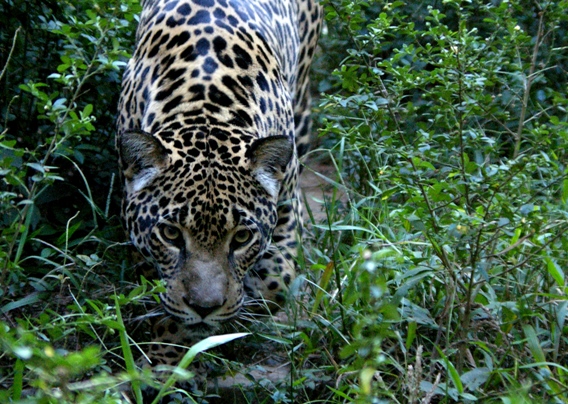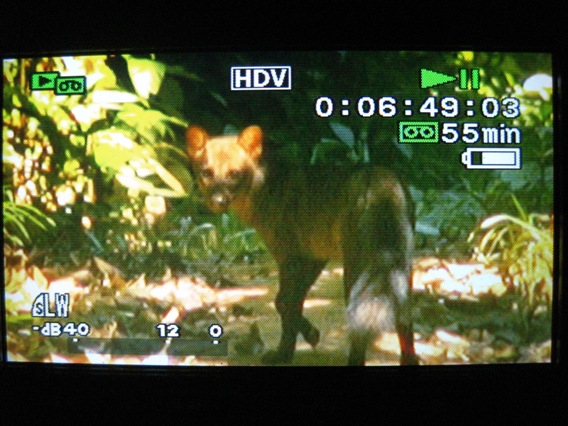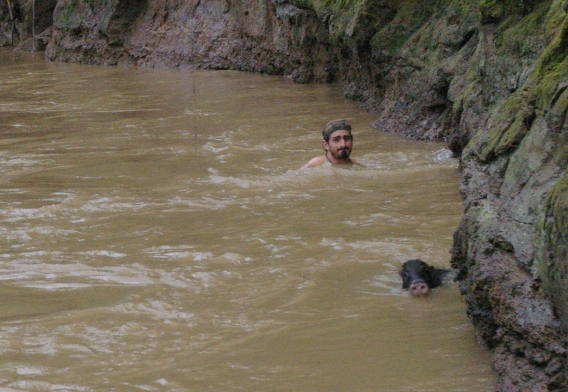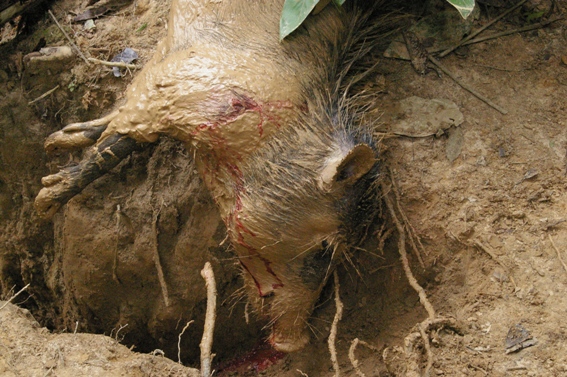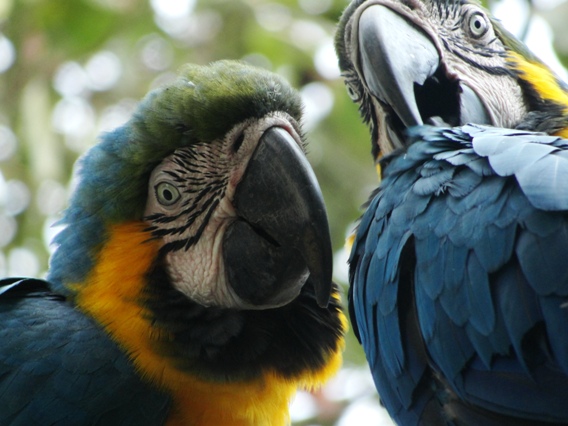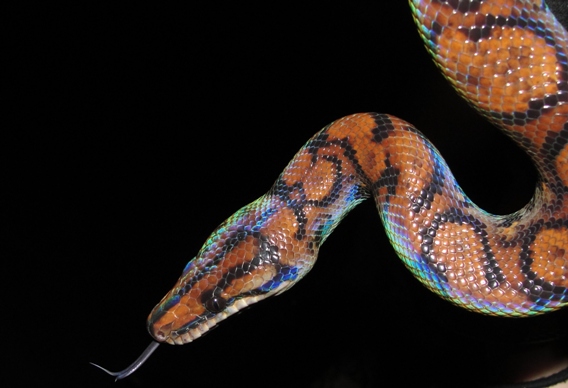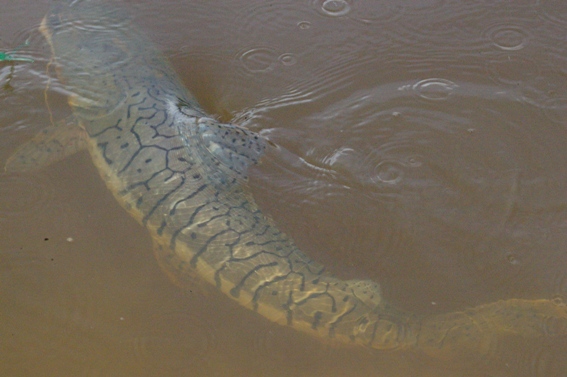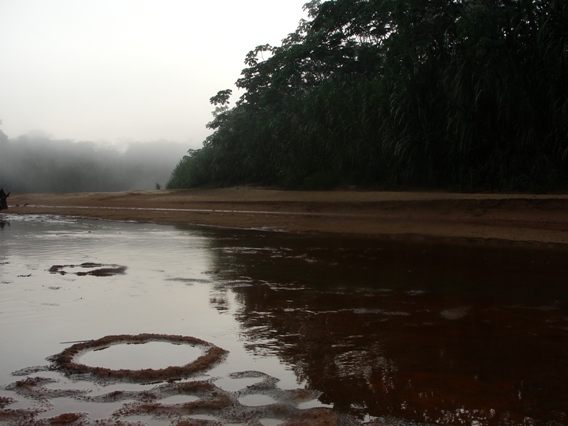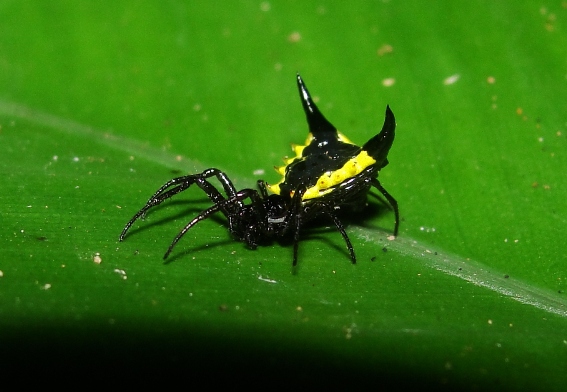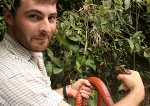If you have been fortunate enough to visit the Amazon or any other great rainforest, you’ve probably been wowed by the multitude and diversity of life. However, you also likely quickly realized that the deep jungle is not quite what you may have imagined when you were a child: you don’t watch as jaguars wrestle with giant anteaters or anacondas circle prey. Instead life in the Amazon is small: insects, birds, frogs. Even biologists will tell you that you can spend years in the Amazon and never see a single jaguar. Yet rainforest guide and modern day explorer Paul Rosolie says there is another Amazon, one so pristine and with such wild abundance that it seems impossible to imagine if not for Rosolie’s stories, photos, and soon videos. This is an Amazon where the big animals—jaguars, tapir, anaconda, giant anteaters, and harpy eagles—are not only abundant but visible. Free from human impact and overhunting, these remote places—off the beaten path of tourists—are growing ever smaller and, according to Rosolie, are in danger of disappearing forever.
“Truly pristine sections of forest in Amazonia are free from any sign of human activity—zero annual river traffic, no trails, trash, chemical pollution, and no machete marks or chopped trees,” Rosolie told mongabay.com in a recent interview. In such places, Rosolie has observed that usually elusive animals behave quite differently.
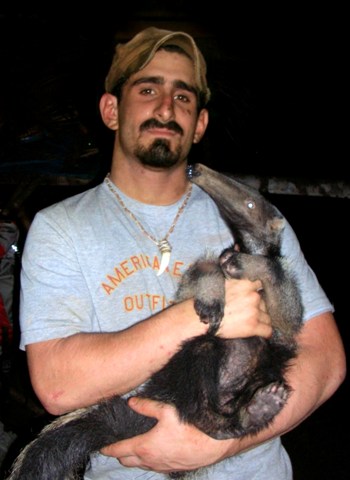 Rescued after her mother was shot by poachers, this baby giant anteater eventually was rehabilitated and released into the wild. Photo courtesy of Paul Rosolie. |
“Animals in truly isolated jungle have no fear of humans. Large herds of peccary are loud and aggressive—the way they should be. The crepuscular habits of the jaguar usually bring it to river’s edge to bask at dawn and dusk. Towering old growth trees surround frequent sightings of giant anteaters, red howler monkeys, macaws, toucans, spider monkeys, capybara, anacondas, tyra, brocket deer, giant armadillo, giant river otter, blue morpho butterflies, the massive black caiman and hundreds of other organisms—it is the most incredible thing on Earth.”
Rosolie says that in Peru, logging, oil, and gold have opened up most of the once wild areas. In addition, some indigenous people and other Amazonian inhabitants are over-hunting to fill a growing market for ‘bushmeat’ and to sell foreigners trinkets made from killed animals.
“Roads give people access to forests which they then begin to settle, clear, hunt, and log. In the Amazon, thousands of tiny tributaries act as roads, allowing human access. Because of this, humans have gained access into even the most insanely isolated areas of the map,” says Rosolie. “This is why a scientist looking for truly pristine area of forest would have to sometimes travel for weeks up a river to reach places where humans do not go. Because of this I feel that the baseline for pristine has become diluted, and we are in danger of forgetting where it really lies.”
Rosolie has recently begun carrying a video camera with him during his forays into the deepest jungle areas. In hopes that the resulting footage will help him bring greater awareness to these places and conserve them, he has started the Junglekeeper Project. Already he has succeeded in capturing what may be the longest video ever recorded of the Amazon’s least known predator: the short-eared dog (the video is not yet released, but a still from it is at the end of the interview).
According to Rosolie, given that truly wild ecosystems have vanished across much of the world, we have forgotten what natural abundance and natural behavior—especially for targeted species—actually is. Even a place as remote and romantic as the Amazon is in danger of being overridden by human impacts.
“I think we need to develop a new classification for forests that have had NO human activities and where the ecological processes are NOT AT ALL disturbed. Having this classification would help us to identify, discuss, and protect remaining areas of truly pristine, ancient forest,” says Rosolie adding that “in megadiverse regions like the Amazon, the Congo, New Guinea, Indonesia and others, being able to distinguish between primary and secondary forest as well as those few remaining places that have escaped all human influence could be a tremendous asset to conservation.”
In the interview that follows Rosolie describes his own experiences on a particularly remote and pristine river. It was on this river that Rosolie was once awoken by a jaguar next to him, but it also on this river he learned first hand how quickly an ecosystem can change when poachers arrive.
In an August 2010 interview with mongabay.com, Paul Rosolie talks about what the pristine Amazonian river looks like and what is threatening even the world’s most remote places.
AN INTERVIEW WITH PAUL ROSOLIE
Mongabay: What is your background? What are your credentials regarding wildlife in the Amazon?
Paul Rosolie: I have a BA in environmental studies, and five years research and exploration experience in the Peruvian Amazon. Since the age of eighteen I have worked as a recruiter, expedition leader, and guide for Tamandua Expeditions in the Madre de Dios.
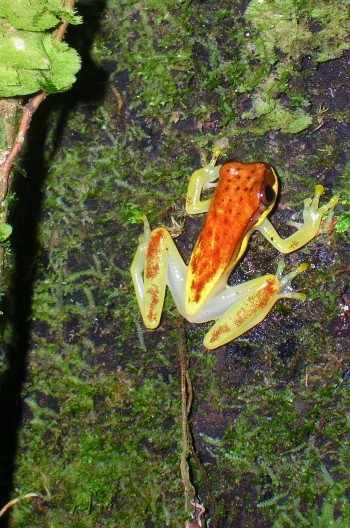 A brilliantly colored frog posing on moss in a swamp in primary forest. Photo by Paul Rosolie. |
Mongabay: Would you consider yourself a modern day explorer?
Paul Rosolie: I do. As human development continues to blanket the Earth, wild places become less wild and cultural diversity is being bleached by globalization. We are most likely one of the last generations to have the opportunity to truly explore. Because of this I take exploration very seriously. In the Amazon, there are some rivers which are so wild and remote that no one has ever seen the source. These are the places I want to see. There is no telling what new species might be found there. Maybe the last population giant ground sloth is still out there somewhere.
HUNTING IN THE AMAZON
Mongabay: In your experience how has hunting impacted even some of the wildest areas of the Amazon?
Paul Rosolie: The demand for mahogany, gold, and oil has fueled exploration into virtually every corner of the map. These teams of men hunt anything and everything they can find while out in the bush—which can sometimes be for periods exceeding two months. This ends up affecting animal populations and behavior over large areas—making them less wild.
Mongabay: What species are directly targeted?
Paul Rosolie: Usually mammal species like peccary and tapir are targeted for meat along with capybara, agouti, paca, armadillo, numerous fish species, Spix’s guan, yellow footed tortoise, and many others. Jaguars, ocelots, anacondas, and black caiman are persecuted for their hides. Macaws are killed for their feathers, or captured for the pet trade.
Mongabay: How does hunting change the Amazon’s animals’ behavior?
Paul Rosolie: Species are forced to become more cryptic in order to survive. On truly wild rivers it is possible to see species such as capybara, tapir, peccary, black caiman, anaconda, and even jaguar out in broad daylight. However the arrival of humans rapidly changes this. Capybara spend less time frolicking in the water, spix’s guans learn not to trumpet when they fly, peccary become more silent, and jaguar become almost entirely nocturnal.
These, of course, are just a few very broad examples—but illustrate the drastic behavioral (and subsequent ecological) changes that can take place because of even a small amount of human hunters. Animals are much smarter than most people give them credit for. Big cats don’t just learn to hunt out of instinct, they are taught to stalk and kill just as giant anteaters learn to open ant mounds—they are taught by mom.
Mongabay: Which species are you most worried about?
 Like the jaguar, tapir become ghosts in the presence of humans. However on wild rivers, sightings are frequent. This seven hundred pounder was seen early morning on the Allegria. Photo by Paul Rosolie. |
Paul Rosolie: In the case of the Amazon, it’s not so much individual species that are of greatest concern, but the integrity of the entire biome. The degradation that is taking place has the power to affect the entire ecosystem and redefine what we consider ‘primary’ or healthy in the Basin. Currently development and human activity is exploding in Amazonia and the next century could see the disappearance of the great jungle we know today.
Mongabay: Why should we be concerned about losing a percentage of the Amazon’s top predators? In other words, why do they matter?
Paul Rosolie: Apex predators are indicators of ecosystem health and exert a profound influence on their surrounding species. One of the greatest illustrations of this is the drastic changes that took place in Yellowstone National Park after the reintroduction of the grey wolf; and in tropical ecosystems the trophic ecology is even more complex. If we want the forests of the Amazon to continue to exist in their natural health, the presence of top predators is crucial.
It is also worthy of note that apex predators have a tremendous tourism value. People want to see the big exciting species. This is a point that should not be overlooked given that many conservation efforts today rely solely on funding from tourism as their hope for success.
STILL PRISTINE
Mongabay: What does the definition of primary forest mean? What do you think that definition is missing?
Paul Rosolie: Primary forest is defined as “forests of native tree species, where there are no clearly visible indications of human activities and the ecological processes are not significantly disturbed”.
But I think we need to develop a new classification for forests that have had NO human activities and where the ecological processes are NOT AT ALL disturbed. Having this classification would help us to identify, discuss, and protect remaining areas of truly pristine, ancient forest. In megadiverse regions like the Amazon, the Congo, New Guinea, Indonesia and others, being able to distinguish between primary and secondary forest as well as those few remaining places that have escaped all human influence could be a tremendous asset to conservation.
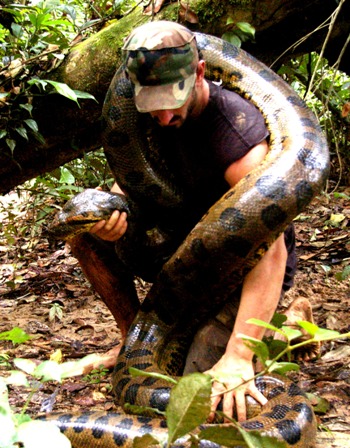 Anacondas are persecuted throughout human-populated areas, many rivers today no longer have anacondas living on their banks, the Rio Allegria provides sanctuary to large individuals. Photo courtesy of Paul Rosolie. |
Mongabay: How would you characterize a truly pristine section of the Amazon?
Paul Rosolie: Truly pristine sections of forest in Amazonia are free from any sign of human activity—zero annual river traffic, no trails, trash, chemical pollution, and no machete marks or chopped trees. I usually look for indicator species which are absent or less abundant in human affected areas. Mahogany is a big one, the tree species has been largely eradicated by consumer demand in many areas, so its presence is a good place to start. Other indicators are signs and sightings of tapir, jaguar, pale winged trumpeters, large groups of peccary, Spix’s guan, black caiman, and a number of others.
You can even use the animal behavior itself to indicate whether humans are present in the area. Much like the world famous Galapagos Islands, animals in truly isolated jungle have no fear of humans. Large herds of peccary are loud and aggressive—the way they should be. The crepuscular habits of the jaguar usually bring it to river’s edge to bask at dawn and dusk. Towering old growth trees surround frequent sightings of giant anteaters, red howler monkeys, macaws, toucans, spider monkeys, capybara, anacondas, tyra, brocket deer, giant armadillo, giant river otter, blue morpho butterflies, the massive black caiman and hundreds of other organisms—it is the most incredible thing on Earth.
Mongabay: Most people who visit the Amazon never see a jaguar, anaconda, harpy eagle, or tapir. What is viewing wildlife like in an untouched section of the Amazon, versus the more well-trodden places.
Paul Rosolie: Well for one thing it’s much easier! When animals aren’t afraid of humans, they are MUCH easier to see. Monkeys and macaws will venture lower in the canopy, offering better sightings, and animals in general are less concerned with our presence. It becomes possible to watch a tapir graze and bath by the riverside, observe a fifteen foot female anaconda enjoying the sun, or see a family of otters playing in an oxbow.
Rainforest lodges and resorts host millions of tourists per year who miss out on seeing so many incredible species. As expedition leader, I bring groups to “primary” and secondary forests that sometimes don’t see all that much wildlife—and it kills me. If pristine areas were more abundant, and as a result more accessible, tourism would benefit tremendously and in turn benefit the conservation of the forests tremendously.
Mongabay: Would you say we have a ‘shifting baselines’ problem even in a place as wild and remote as the Amazon?
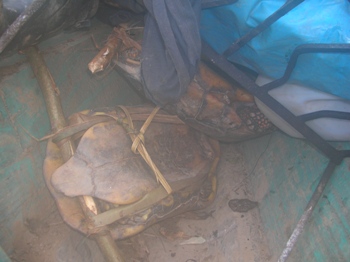 Packed into the bottom of a poaching boat, several large yellow-footed tortoises await an axe and then the soup pot. Yellow-footed tortoises are a beautiful and slow species and are one of the first to be impacted by human hunting. Photo by Paul Rosolie. |
Paul Rosolie: Absolutely. We all know the story, its rainforest conservation 101: roads give people access to forests which they then begin to settle, clear, hunt, and log. In the Amazon, thousands of tiny tributaries act as roads, allowing human access. Because of this, humans have gained access into even the most insanely isolated areas of the map. This is why a scientist looking for truly pristine area of forest would have to sometimes travel for weeks up a river to reach places where humans do not go. Because of this I feel that the baseline for pristine has become diluted, and we are in danger of forgetting where it really lies.
Mongabay: Do you believe that even scientists have a mistaken view of the wildlife in the Amazon?
Paul Rosolie: I certainly fear it. Not because of any incompetence or fault of their own, but because of how difficult it is to find un-impacted forest/rivers. Finding untouched areas has been my passion for quite some time, and even I have never found a place that is 100% pristine. Even after traveling upriver for almost a week on remote rivers to places where the animal populations seem almost at their peak, you almost always will spot some tiny indication that humans have been through at some point—a coke bottle, an empty rifle shell, or a machete mark on a tree.
THE ‘ALLEGRIA’ RIVER’
Mongabay: Can you tell us about the ‘Allegria River’?
[Note from Rosolie: . *The name Allegria is actually a pseudonym I am using to protect the true identity of the river, myself, and the study which I am building.]
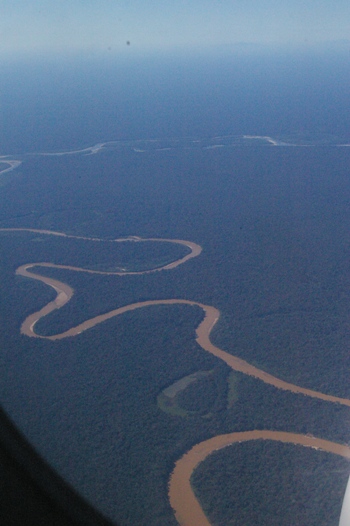 Winding through impenetrable jungle, the Allegria. Photo by Paul Rosolie. |
Paul Rosolie: The Allegria snakes through lowland rainforest just inside the boundaries of a major national park, in the shadow of the Andes, the abundance of wildlife on this river is explosive. The river is a near pristine ecosystem and provides habitat to the full range of indigenous wildlife. It is the wildest river I have ever seen.
Over the past three years, on several week-long visits, I have been conducting a biodiversity survey which has yielded incredible numbers. Of 125 beaches observed in different years and at different times of the year, every single one has held between one and three sets of jaguar tracks, and between two and four sets of tapir tracks, as well as regular sightings of the latter. Along with these are constant evidence and sightings of capybara, black caiman, anaconda, giant river otter, tyra, peccary, monkeys, and more. The river has clay licks that are habitat for four species of macaw, and even harpy eagles are abundant to the extent of almost being common. It is paradise. Its source is so isolated and remote that un-contacted tribes still inhabit the forest there—in the dry season it is possible to see the footprints and excavated turtle nests they leave behind.
Recently however there has been an influx of hunting on the Allegria that is changing this wild river and threatening its ability to provide sanctuary for endangered species, and isolated cultures
Mongabay: How do you reach this river?
Paul Rosolie: Because it lies inside of the national park, there is a guard station at the mouth of the river which allows only people of indigenous heritage through. So sometimes my native friends can sneak me through on their boat, but other times I have to go solo, and that is a different story. The only way to reach the Allegria is to get dressed like a local, and board a once-per week indigenous taxi that travels far up a large river. After eight or nine hours travel into the jungle when we are upriver of the guard station and the mouth of the Allegria, I get off. Then starts an expedition through un-trailed jungle that has sometimes taken hours, and other times days.
My first solo expedition in the Amazon was a journey to the Allegria, and the first night I slept in the forest alone, a jaguar woke me during the night. I woke up in my hammock to the sound of breathing, and when I tried to turn on my headlamp was paralyzed by a warning growl which came from two inches away from my right temple. She left soon after without making a sound—but it was one of the most incredible experiences of my life—and a perfect example of the adventure that comes with wild places—that cat had NO fear of humans, not one bit.
Mongabay: How does the Allegria River serve as an example of the impact of hunting on wild populations in the Amazon?
Paul Rosolie: It opened my eyes to the substantial effects which even a small amount of human activity can have on a natural area. There has been a noticeable decline on the river in just the limited time I have observed it. Locals recall the days when jaguars could still be seen on the Allegria’s beaches basking in the sun, free from fear and at the top of their food chain. Today jaguars can no longer be seen basking on the banks of the Rio Allegria. They are still there certainly, but have become increasingly cryptic. Tapirs too have become scarcer along with black caiman, capybara, and even anaconda—a species which the river has been notoriously rich with in the past.
Mongabay: Who is doing the hunting?
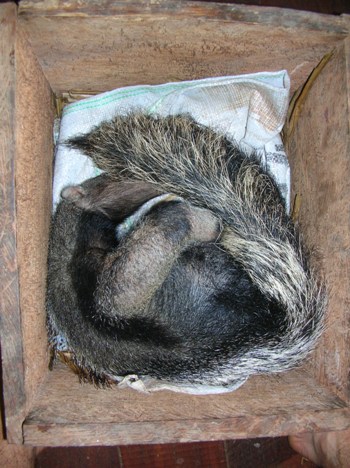 Orphaned because of hunting, this baby giant anteater was found on the river Las Piedras. Photo courtesy of Paul Rosolie. |
Paul Rosolie: Because the Allegria lies inside the boundaries of a national park, only people of indigenous heritage are allowed past the guard station at the mouth of the river. Their community lands have been overhunted, and are missing favored species like peccary, tapir, and Spix’s guan. Because it is so isolated and wild, they come to the Allegria to pursue what they can no longer find at home. In the past few years however, the hunters have begun to exponentially increase their efforts to supply a growing bush-meat market in cities and towns.
Mongabay: Shouldn’t indigenous communities have the right to hunt for food as they have for millennia?
Paul Rosolie: Yes. However, in the case of the Allegria we are dealing with lands which are supposed to be protected by the national park, and these people are not hunting for subsistence. Today many indigenous people are in a period of simultaneity. They no longer rely on the forest for survival in the hunter-gatherer sense of the word. These are people who have jobs, motorbikes, guns, and who make money. They are also people who have already emptied their own forests of viable populations of game species. Many of the hunters accessing the Allegria today, a river inside of a national park, are not hunting for their own families, but for profit—and it’s easy to prove. The 120 Peruvian soles in gasoline required to fuel the eight hour boat ride to the Rio Allegria could be spent on a month’s worth of rice and chicken in town. But hunting wild game is good profit, and more fun. They are exploiting a rule of the park that was made to accommodate and respect their way of life, and have become nothing more than poachers.
I have seen hunters return from the Allegria with as many as eight peccary carcasses at a time. I have seen macaws shot for their feathers, black caiman hides stowed in the bottom of boats along with piles of yellow footed tortoises, mass quantities of fish, and it is getting worse. I once watched a man shoot a monkey because he was bored and wanted to fish for piranha.
As a result of the motors and guns and other human activity, I have seen a noticeable change in the Rio Allegria over the past three years.
Mongabay: Who buys the wild game meat and other animal parts?
Paul Rosolie: Meat from peccary and tapir make their way into local markets. So too do feathers, hides and captive animals which satisfies the demands of foreigners.
Mongabay: Do you think park managers are aware of what’s going on inside the park?
Paul Rosolie: Because I am not actually allowed to be on the Allegria, it makes asking questions and showing study results difficult. However I don’t think that the park managers are aware of what is happening—or at least aware of the changes it is causing. This is why I am hoping to use documentary footage and study results to bring attention to the problem, and hopefully stay out of trouble.
OTHER PROJECTS
Mongabay: You’ve started a new initiative called the Junglekeeper Project. Will you tell us about this?
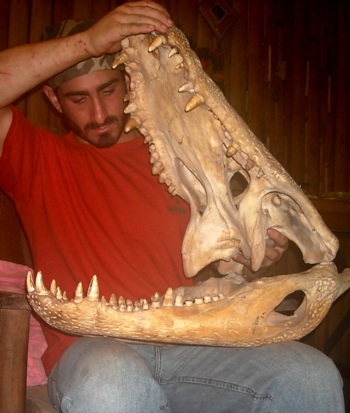 Black caiman are the Amazon’s largest predator, and one of its most endangered species. This mother black caiman was shot by a frightened farmer while guarding her nest. Black caiman, reaching lengths of 17 feet, are the largest predator in Amazonia and are endangered throughout their range. Photo by Paul Rosolie. |
Paul Rosolie: Certainly! The Peruvian Amazon is one of the most intact regions of lowland rainforest on Earth, and is currently on the brink of being opened up and destroyed by a number of forces looming on the horizon. Massive dam projects, big oil, roads, and gold operations threaten to turn one of our last great wildernesses into something very different, and I can’t bear to watch.
The Junglekeeper Project is nothing more than my plan to take a camera into some of the wild places that will be destroyed by these projects and show people what we are about to lose. I want to interview the native peoples who will be displaced by dams, show the pristine rivers which are at risk from oils spills, and hopefully make enough noise to cause some change and save the region. Best case scenario if it works, it can then be duplicated in other parts of the world.
In order for our grandchildren to have an Amazon Jungle, or polar bears, or wild tigers, everyone needs to become involved in conservation—not just conservationists. And I think I have an idea of how to make it happen.
Mongabay: On your most recent trip to Peru you began filming wildlife and the region. What are you hopes for this footage?
Paul Rosolie: This footage is the beginning of the Junglekeeper Project. The plan is basically to put together a sort of resume piece that could be used to attract the funding and media attention needed to get the Junglekeeper Project rolling full steam. In order to be effective, the message needs to reach millions of people and arm them with the knowledge they need to join in—and it needs to happen fast! I am hopeful however because the Amazon is a beautiful and exciting place—people will want to help save it if they know how.
As far as filming, we had some truly awesome luck for a first time try. We filmed macaws in the wild, red howler monkeys, blue crowned motmots, as well as encounters with crocs, anacondas, the floating forest, a nine foot boa constrictor, and even the elusive short eared dog was caught on tape. We also were able to capture poachers in action on more than one occasion.
To read another interview about Paul Rosolie’s discoveries in the Amazon: Secrets of the Amazon: giant anacondas and floating forests, an interview with Paul Rosolie
As the largest mammalian predator in its range, the jaguar enjoys the top of the food chain. The presence of humans however forces this apex predator to become almost entirely nocturnal – making sightings almost impossible. Photo by Paul Rosolie.
One of the rarest, and little known species in the Amazon, the short eared dog. Filming over four minutes of footage with the canine, the Junglekeeper Project may have recently filmed the most extensive video of this species to date. Still from video footage by Paul Rosolie.
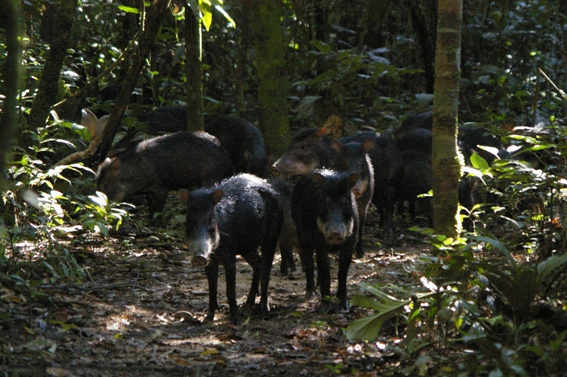
In healthy forest, herds of peccary occur in large numbers and are abundant. Knowing no fear of humans, this herd stands its ground hoping to drive away the photographer. Photo by Samuel Hanna.
A poacher’s boat intercepted and trapped a herd trying to cross a river, killing as many as they could with machetes before our boat pushed them away. This photo is was taken while trying to rescue the exhausted and drowning individuals who remained. Photo by Edward Rosolie.
.
Peccary are the most persecuted of any species by hunters. Photo by Paul Rosolie.
.
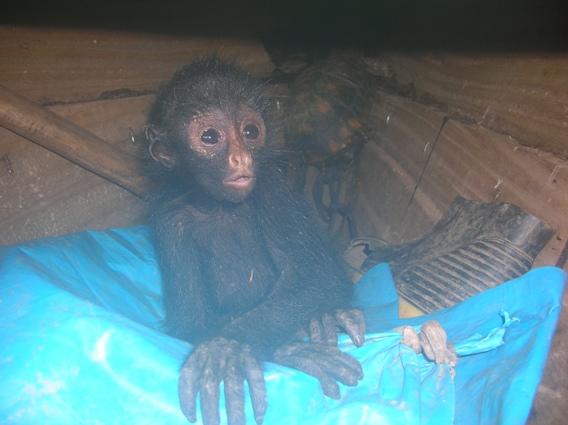
Macaw feathers, caiman hides, tortoises and other animal parts surround this baby spider monkey on this poaching boat. Photo by Paul Rosolie.
Some of the beautiful inhabitants of the Allegria, blue and yellow macaws. Photo by Paul Rosolie.
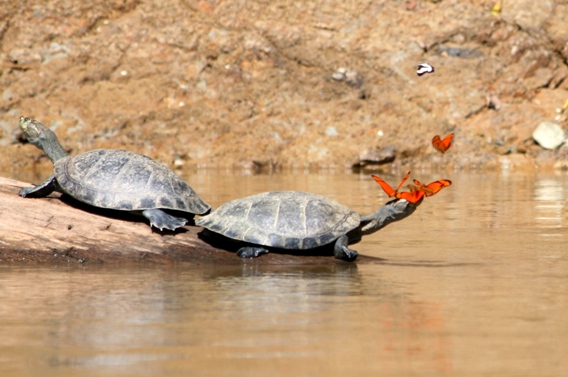
River turtle eggs are collected by humans, reducing the number of this riverside species in many areas. On wild rivers these turtles line the banks – often with butterflies on their noses. Photo by Samuel Hanna.
One of the most beautiful snake species, the rainbow boa. Photo by Gowri Varanashi.

The galliwasp lizard is a perfect example of the rare and endemic (occurring nowhere else) species found in various regions of the Amazon. Photo by Emma Hume.
One of the most heavily sought after fish in the Madre de Dios, the beautiful donsaya catfish, reaching lengths of four feet, is under tremendous pressure. Photo courtesy of Paul Rosolie.
Deep in the jungle, stingray tracks line the soft sand on the wild banks of the Allegria. Photo by Paul Rosolie.
An unidentified spider on a leaf. Photo by Paul Rosolie.
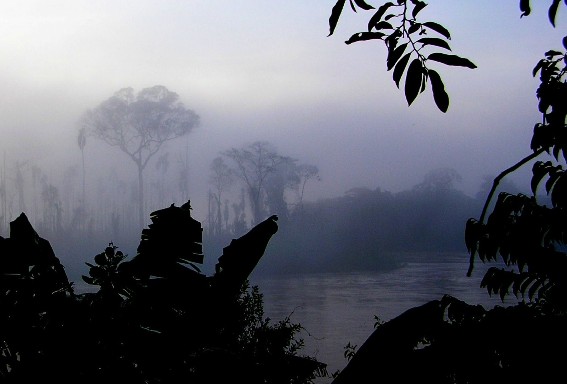
An early morning view of deep jungle. Photo by Paul Rosolie.
Related articles
Secrets of the Amazon: giant anacondas and floating forests, an interview with Paul Rosolie

(03/10/2010) At twenty-two Paul Rosolie has seen more adventure than many of us will in our lifetime. First visiting the Amazon at eighteen, Rosolie has explored strange jungle ecosystems, caught anaconda and black caiman bare-handed, joined indigenous hunting expeditions, led volunteer expeditions, and hand-raised a baby giant anteater. “Rainforests were my childhood obsession,” Rosolie told Mongabay.com. “For as long as I can remember, going to the Amazon had been my dream […] In those first ten minutes [of visiting], cowering under the bellowing calls of howler monkeys, I saw trails of leaf cutter ants under impossibly large, vine-tangled trees; a flock of scarlet macaws crossed the sky like a brilliant flying rainbow. I saw a place where nature was in its full; it is the most amazing place on earth.”
Guyana bans gold mining in the ‘Land of the Giants’

(03/01/2010) Guyana has banned gold dredging in the Rewa Head region of the South American country after pressure from Amerindian communities in the area. A recent expedition to Rewa Head turned up unspoiled wilderness and mind-boggling biodiversity. The researchers, in just six weeks, stumbled on the world’s largest snake (anaconda), spider (the aptly named goliath bird-eating spider), armadillo (the giant armadillo), anteater (the giant anteater), and otter (the giant otter), leading them to dub the area ‘the Land of the Giants’. “During our brief survey we had encounters with wildlife that tropical biologists can spend years in the field waiting for. On a single day we had two tapirs paddle alongside our boat, we were swooped on by a crested eagle and then later charged by a group of giant otters.”
Mahogany market in US threatening the lives of uncontacted natives in the Amazon

(07/20/2010) Consumers in the US purchasing mahogany furniture may be unwittingly supporting illegal logging in a Peruvian reserve for uncontacted indigenous tribes, imperiling the indigenous peoples’ lives. A new report by the Upper Amazon Conservancy (UAC) provides evidence that loggers are illegally felling mahogany trees in the Murunahua Reserve where it is estimated some 200 uncontacted natives live.
Environmentalists and indigenous groups condemn plan for six dams in Peruvian Amazon
(06/21/2010)
Environmentalists and indigenous groups have come together to condemn a 15 million US dollar plan for six hydroelectric dams in the Peruvian Amazon, signed last week by Brazilian President Luiz Inácio Lula da Silva and Peruvian President, Alan Garcia. While the six dams would produce over 6,000 megawatts, mostly for Brazil, critics say the dams will flood tens of thousands of hectares of rainforest, devastate the lifestyles of a number of indigenous groups, and only serve big Brazilian corporations.
More of the Amazon opened to oil development

(05/24/2010) Perupetro, the Peruvian government’s oil and gas corporate leasing body, announced last week that it will open an additional 25 lots for oil and gas exploration in the Amazon covering an area of 10 million hectares (nearly 25 million acres). Peru’s national Amazon indigenous group, AIDESEP, criticized the move calling it a ‘new threat’ to Peru’s indigenous group. According to Amazon Watch these new lots mean that 75 percent of the Peruvian Amazon is now open to oil and gas exploration and drilling.
Illegal logging rampant in Peru
(02/15/2010) A survey of 78 forestry concessions in Peru found that 46 (59 percent) were in breach of their concession contracts, reports the International Tropical Timber Organization (ITTO).
Roads are enablers of rainforest destruction

(09/24/2009) Chainsaws, bulldozers, and fires are tools of rainforest destruction, but roads are enablers. Roads link resources to markets, enabling loggers, farmers, ranchers, miners, and land speculators to convert remote forests into economic opportunities. But the ecological cost is high: 95 percent of deforestation in the Brazilian Amazon occurs within 50-kilometers of a road; in Africa, where logging roads are rapidly expanding across the Congo basin, the bulk of bushmeat hunting occurs near roads. In Laos and Sumatra, roads are opening last remnants of intact forests to logging, poaching, and plantation development. But roads also cause subtler impacts, fragmenting habitats, altering microclimates, creating highways for invasive species, blocking movement of wildlife, and claiming animals as roadkill. A new paper, published in Trends in Evolution and Ecology, reviews these and other impacts of roads on rainforests. Its conclusions don’t bode well for the future of forests.
Heavy oil pollution remains in Amazon, despite company claiming clean-up is finished
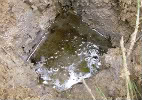
(09/17/2009) A new report shows that the Corrientes region of the Peruvian Amazon, which suffered decades of toxic contamination by Occidental Petroleum (OXY), is far from being cleaned-up. The survey, conducted by US non-profit E-Tech International, found that heavy metals, volatile organic compounds, and hydrocarbons still exist at levels above the safety limits set by Peru and continue to threaten the Achuar indigenous community, who have long fought against the oil companies.
New Amazonian reserve saves over a million acres in Peru
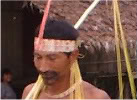
(08/30/2009) On August 27th Peru’s Ministry of the Environment approved the creation of the Matses National Reserve to protect the region’s biodiversity, ensure its natural resources, and preserve the home of the Matses indigenous peoples (known as the Mayorunas in Brazil). The park is 1,039,390 acres (or 420,626 hectares) of lowland Amazonian rainforest in eastern Peru. The park is the culmination of over a decade of work by the local non-profit CEDIA (the Center for the Development of the Indigenous Amazonians) funded in part by the Worldland Trust.
(06/06/2009) More than 70% of the Peruvian Amazon has been allocated for oil and gas extraction, and the current government of Alan Garcia has been pushing for more. Unfortunately, as usual, these policies are promoted by and only benefit a handful of people, but negatively impact the lives of many. However, Garcia’s government did not foresee the potential consequences of their actions.
Peru gets $120m to protect 212,000 sq mi of Amazon rainforest
(05/13/2009) The Japanese government will loan Peru $120 million to protect 55 million hectares (212,000 square miles) of Amazon rainforest over the next ten years, reports El Comercio.
Amazon rainforest in big trouble, says UN
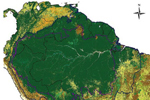
(02/19/2009) Economic development could doom the Amazon warns a comprehensive new report from the United Nations Environment Programme (UNEP). The report — titled GEO Amazonia [PDF-21.3MB] — is largely a synthesis of previously published research, drawing upon studies by more than 150 experts in the eight countries that share the Amazon.
Payments for eco services could save the Amazon

(02/12/2009) Paying for the ecological services provided by the Amazon rainforest could be the key to saving it, reports a new analysis from WWF. The study, Keeping the Amazon forests standing: a matter of values, tallied the economic value of various ecosystem services afforded by Earth’s largest rainforest. It found that standing forest is worth, at minimum, $426 per hectare per year.
Peru seeks $200 million to save its rainforests
(12/08/2008) Peru is seeking $200 million in international contributions over the next ten years to cut deforestation to zero, reports BBC News.
(11/29/2009) An expedition deep into Guyana’s rainforest interior to find the endangered giant river otter—and collect their scat for genetic analysis—uncovered much more than even this endangered charismatic species. “Visiting the Rewa Head felt like we were walking in the footsteps of Wallace and Bates, seeing South America with its natural density of wild animals as it would have appeared 150 years ago,” expedition member Robert Pickles said to Mongabay.com.
Hunting across Southeast Asia weakens forests’ survival, An interview with Richard Corlett

(11/08/2009) A large flying fox eats a fruit ingesting its seeds. Flying over the tropical forests it eventually deposits the seeds at the base of another tree far from the first. One of these seeds takes root, sprouts, and in thirty years time a new tree waits for another flying fox to spread its speed. In the Southeast Asian tropics an astounding 80 percent of seeds are spread not by wind, but by animals: birds, bats, rodents, even elephants. But in a region where animals of all shapes and sizes are being wiped out by uncontrolled hunting and poaching—what will the forests of the future look like? This is the question that has long occupied Richard Corlett, professor of biological science at the National University of Singapore.
